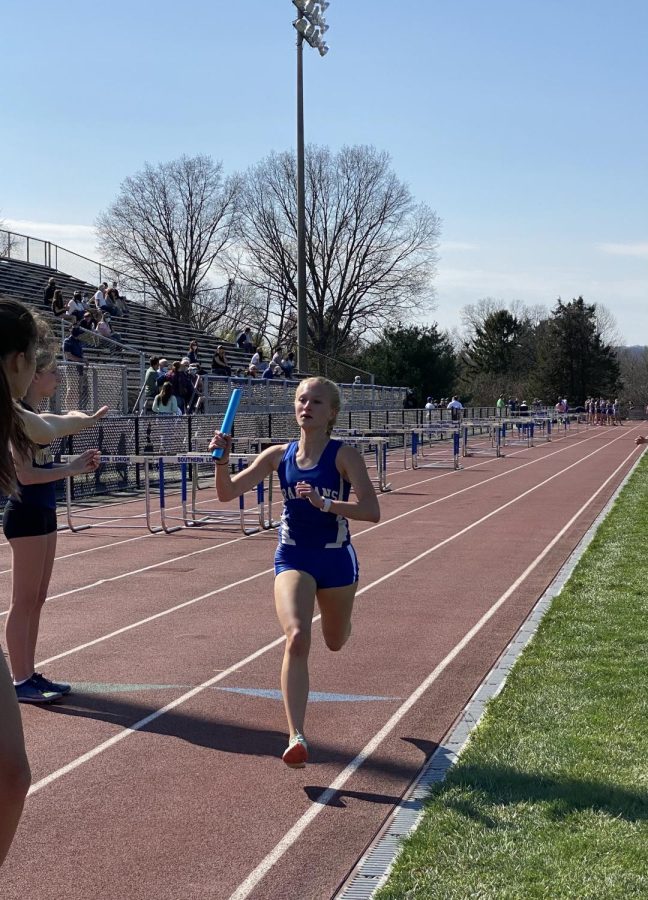Sexual Discrimination Still Persists in Sports
Senior Autumn Garges passes baton in girls 4×800 meter relay.
Since the early 1960s, the fight for gender equality in sports has seen many ground-breaking changes. Even while there is ever-growing emphasis on leveling the playing field, there is still much work to be done in the perception of men’s and women’s sports themselves. Typically, successes in men’s sports are more celebrated by the media and spectators than women’s sports.
“I think just across the board of professional sports there is always an expectation for men to outperform women regardless of the sport,” senior Autumn Garges said. “Women are not seen [as being] as powerful and strong as men are.”
According to UNESCO, women only receive about 4% of sports media coverage, leaving the other 96% for men’s sports. With less media coverage, events are bound to be less advertised, resulting in lower income from the matches. This can influence the gender pay gap within sports.
Even in a non-professional environment, gender inequality is still an issue. Many high school athletes participate in club sports, which have disparities in coaching. For some of these club sports, coaching and recruiting priorities are given to the men’s teams.
“In terms of coaching, our coaches [have] just grown into their coaching position and a lot of times the guys have a staff that [is experienced],” junior lacrosse player Jessica Mantz said.
High school sports provide opportunities for teenagers to participate in sports, whether it’s for fun, or attempting to play in college. Although these sports are more regulated to provide the most equal experiences, some sports still witness biases.
“I remember specifically doing a track workout that was supposed to be 8-10 repetitions depending on how we were feeling. After 8, I still felt good. I saw the boys were going up to 10 so I asked an assistant coach if I could go up to 10 and I was told to cut the attitude, only the boys were doing 10,” Garges said. “To me it felt like we were seen as incapable.”
However, there is a bright side to the issue. Since the passing of Title IX in 1972, the percentage of female high school athletes jumped from 7% to about 43% according to the National Coalition for Women and Girls in Education (NCWGE). Students continue to raise awareness and share ways to raise these numbers even higher.
“I think we can achieve [equality] just by treating everyone equally, whether they’re of the same sex or not,” freshman Ryan Schaller said.
The fight for equality cannot end now; there are still instances of inequity that remain in the sports environment. Within Southern Lehigh, many of the boys basketball games have a drastically large number of student spectators compared to the girls’ games. The student section averages 32 students for girls games, and around 109 students for boys games.
“I think it has to do a lot with supporting female athletes,” Mantz said. “I think that when a boys team makes it to districts, you see more people going to the games. For female teams they could go just as far or farther, and there aren’t as many people supporting them.”
Students can address these disparities by attending more female sports games, as well as helping to support female athletes more equally for their accomplishments. Students should support their teams, regardless of gender, which can start within the team itself.
“I think the [track] team is very close and supportive of each other,” assistant track and field sprints coach Michelle Schumaker said. “If somebody is having a down day, athletes reach out to each other to help bolster their spirits, and everybody is there to applaud them.”
It must be acknowledged that women’s sports have come a long way since their beginning, with increased participation, increased awareness, and more people standing up for their rights.
“I have seen a lot of women standing up for themselves and proving how strong and capable they are – which I love to see,” Garges said.

Senior Alaina Patel is a second-year staff reporter and the current Features editor. She is a captain of the cross country team, NHS treasurer, Key Club...


